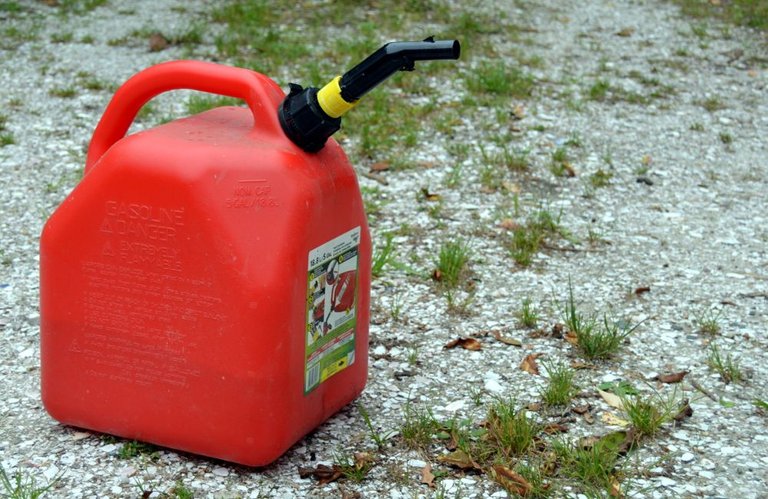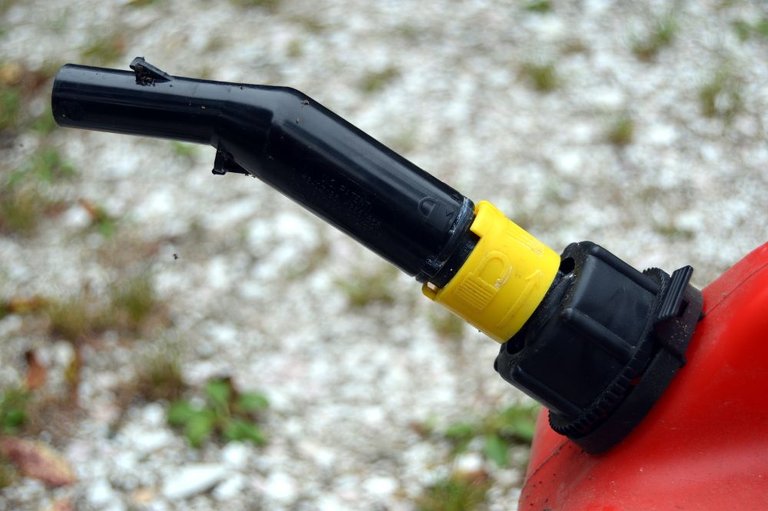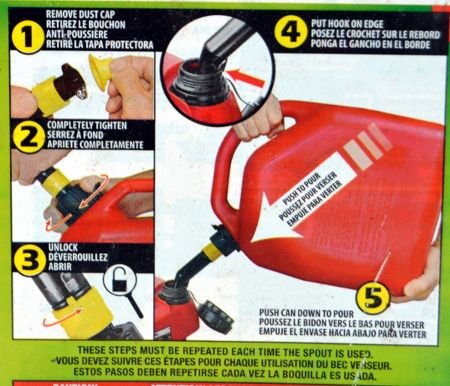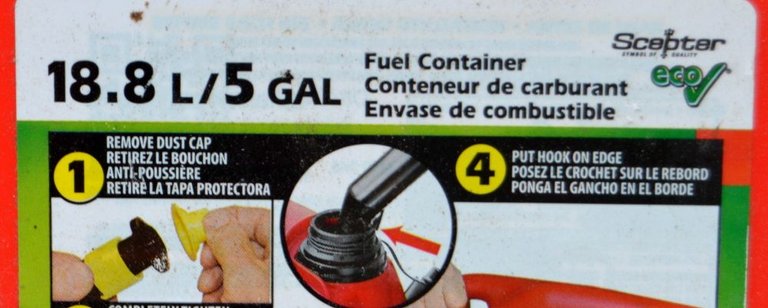This is our new gas can. It has one function to perform.
It's horrendously, egregiously, hazardously abysmal at it. This product is so biblically terrible that its design threatens the fabric of rationality. And it could very well burn down your house.

Our old gas can was simple. A bright red receptacle for petrol with a spout and a cap. The cap was there to hold the gas in. The spout was there to pour it out. The bright red color indicated that the stuff inside it was dangerous. It lasted for over a dozen years before it started to leak. Leaking gas is a dangerous situation! So of course we wanted a new can that was sturdy and safe.

Well, this thing has no shortage of safety features. At $30, it ought to, right?
Take a look at that spout. At the base, there's a row of teeth to to lock the lid tight, with a plastic tab you need to hold down to release it. I call these teeth "the finger shredders." We'll come back to those in a moment.
Then you'll notice a yellow locking mechanism. It turns out you can't pour gas through this spout until you've rotated that band a quarter turn counter-clockwise. Even then, the gas doesn't flow. You see those plastic tabs near the tip of the spout? You've got to press those up against the edge of the tank you're trying to fill, and then push the whole can down to open the valve. It will only dispense gas while you're pushing against the spout. And when you stop, the yellow mechanism will pop back into the locked position.

All of this is laid out in the handy five-step instruction sticker at the front of the can. I guess I should have read the instructions before trying to use this thing. But, c'mon, it's a friggin' gas can!
Here's the thing. Gas is heavy. This can weighs over 30 lbs when it's full. You've got to balance that weight over a lawn mower, chainsaw, or weed trimmer, and then push with enough force to let the fuel flow while not flipping your appliance over. It's absurd. It even looks absurd in the picture on the instruction label, there. It's an operation that takes at least two people to perform, and it requires the subtle muscular control of an Olympic gymnast to get the force just right.
Meanwhile, the seal inside the spout is nothing more than a cheap rubber ring that's easily misaligned. That means that while the spout is stoutly holding back 30 lbs of fuel for your safety, a lot of that fuel is leaking out around the valve, splashing all over your hands, equipment, and clothing. The only way to prevent this is by cranking it tight with enough force to crush bone. But because all that gas is so slippery, the only way to get enough grip to do this is by grabbing those teeth and shredding your fingers in the process. Good luck getting it off again later!
I've spilled so much gas wrestling with this piece of garbage that the Environmental Protection Agency is likely to come knocking on my door. But eventually I discovered that I could just discard the spout and pour directly. While this creates its own hazards, it's generally much less dangerous than using the "safety spout". (It's also much better for my mental health.) With the application of an improvised funnel we've been able to get the same functionality out of this can as we had from the old one, although fueling up the lawn tractor is still a two person job - one to hold the funnel and one to pour.

Lawn care seems particularly riddled with safety features which create more hazards than they prevent, and which most people find a way to bypass at the earliest opportunity.
Think of those bars on lawn mower handles which you have to press down to keep the engine running. I don't think I've ever seen a mower where those haven't been tied or taped permanently down. My aging lawn tractor has this irritating feature where getting out of the seat kills the engine. But because the engine is so hard to start, I'll stretch and lean and bend heaven and earth to avoid getting off if I need to move something out of my way, nearly tipping the damn thing over. Even my weed-trimmer and chainsaw require pressing two buttons simultaneously to activate them - a seemingly minor inconvenience which puts an awful lot of stress on my tendons.
For God's sake, these are dangerous tools: hand-held internal combustion engines that ignite liquid explosive in order to spin sharp blades around. How safe are they expected to be?
Essentially all these features give the manufacturers a "get out of jail free" card in the case of customer injury, while providing customers with products that are less functional and even more dangerous than they should be.
But this gas can, man, this takes the cake for unnecessary hazard.
It's made by a company called Scepter. Here's a close up of the label so you can avoid picking one up yourself.

So how about you? What safety features have you had to overcome to make it through your day, today?
These things are ridiculous. Thank your for putting together an article that finally explains how horribly dangerous these new "safety" devices are. I am upvoting, resteeming, and sharing with our friends on Facebook.
Preppers, survivalists, and homsteaders, don't forget to use the #preppers hashtag in your posts. This will help us to discover your content to upvote and resteem.
Want to find more preppers to follow? We follow every homesteader and prepper we find. Go here to meet others.
If you would like a preppers badge like the one below, check out @daddykribs You can learn how to request your badge from his post here
Thanks, @preppers! I appreciate the read and re-steem!
Nice information
Not like only gas can there are so many features we use for our safety but they just sweepingly take us to death.
Great post! So many homes in Alaska are reliant on gas cans for many projects such as heating homes, filling generators, snowmachines, and more. I have seen a few accidents from the so called safety cans, and too many spills to even count. I don't know why we replace common sense with safety features that essentially put us in more danger. Thanks again for your post
And thank you for reading! That's interesting to hear about these cans in Alaska - I can't imagine how much people must have to rely on portable fuel up there.
I have those bars on my lawnmower, not taped. I like it, it's a good safety feature!
Some safety stuff is junk though. I remember when safety scissors were a thing earlier in life... yuck!
Safety scissors! Memories of 2nd grade art class...too funny.
I find that bar gives me callouses after a couple hours of work, not to mention the aggravation of having to pull-start it again every time it turns off. But maybe a newer machine wouldn't be so hard to manage.
Spill more, buy more :) Everything nowadays is made like shit so we just keep on shopping! I want the old days back, where things were made to last, and made COMMON SENSE! No more kids gloves, this it getting out of control!!
We are giving this post our support. Thank you for sharing!
Thanks, @americanpreppers! I definitely appreciate the support!
definitely worth the upvote. I really hate these things
Glad I'm not alone! I thought I might be over-reacting but this really is a dangerous produce.
Its just crazy. Instead of giving people fair warning to make the safety decisions themselves they're too busy trying to create failsafes to protect us, causing more problems in the long run.
Toss that trashy thing and get the German design Jerry can. It actually works well. The new ones have the nanny spouts but I hear they are OK. I think Lexington Containers has the cans and spouts. Pricey but at least the old ones are great.
Wow, those look pricey. But probably worth the investment if I end up doing much more work outside. We'll see how long I want to put up with my milk-jug funnel!
I totally get that they are pricey. For casual work around the house, most anything will do. I bring my cans on the road, so they have to be sturdy and secure. I envision having to refuel in a big ass hurry, in the dark and in bad weather. The J cans and a self-priming siphon are a lot of money, but man it's a system that just works well.
Well, if we keep losing power around here as often as we have been, I'll definitely grab one of these for our diesel generator.
I like that the cans come in colors: Red for gasoline, yellow for diesel and blue for water. Great stuff!
I do too - except that blue cans are for kerosene!